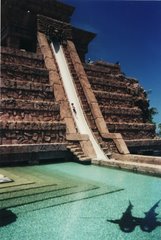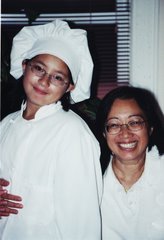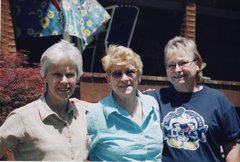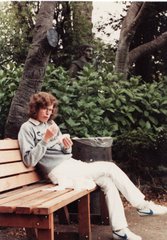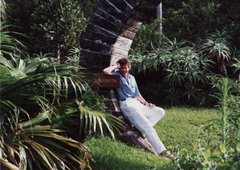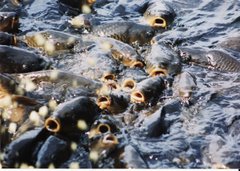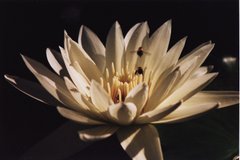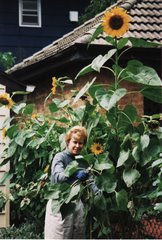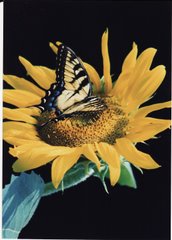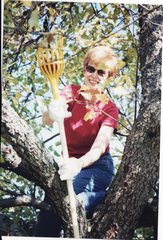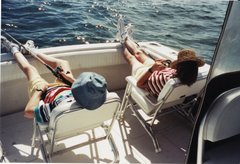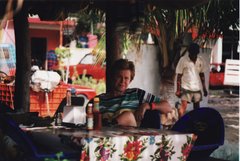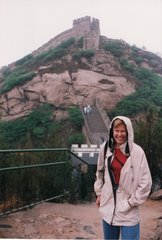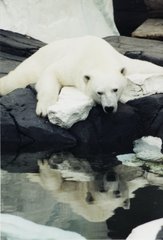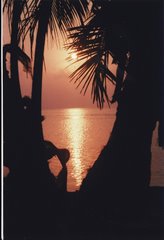Tuesday, May 26, 2009
Friday, May 22, 2009
My Neighbor Mrs. Haight
All of this was before my time. I only know about it because they taught it in American history class and I’ve heard some stories from my parents and other older folks about how difficult things were here in the States during the war. Rationing stamps, bread delivery cards, war bonds and victory gardens all seem like a romanticized story about a very black time in our history for me.
In 1954 I was going on six years old and lived in Missouri on a very small farm with my grandparents. The town was maybe 200 people total; all god-fearing people struggling to make ends meet. It was a time of wonderment for me; I was too young to know about poverty or a lot of the other real problems that grown-ups had to deal with. My grandparents made sure they did not burst that bubble for me either. I did know that money was a hard thing to come by and if you earned any, you would spend it very wisely.
It didn’t take very long for me to get to know everybody in my immediate neighborhood. My grandmother would take me on walks to the corner store about a half-mile away and everyone who lived along the way became another friend for me. Of course I would help carry the stuff back from the store and that endeared me to a lot of folks. The lady who lived right next door, Mrs. Haight, was one of those people. She thought it was just soooo wonderful that I helped my grandmother as much as I did. I thought it was the least I could do.
One day Mrs. Haight called me over and asked me if I would walk to the spring which was near to the corner store and bring her back two gallons of spring water. She really preferred the spring water to the well water from the pump in the back yard. She said she would pay me a dime if I would do that for her. She was quite old and I thought it would be a neighborly thing to do. The dime…well, my mind danced with anticipation of the stuff I could buy with all that money.
Yes, I’ll be happy to do that for you I said beaming as I grabbed the two empty glass gallon jugs. Off I went, in my own reverie on my half mile hike to the spring one jug in each hand. Going was pretty easy, filling the jugs was a snap, but carrying them back was another story. I started walking and got about a block away and realized that these jugs were pretty heavy when they were full.
I stopped several times before I made it back to Mrs. Haigts’ place. I realized that the trip was worth the dime; this is really hard work. But I promised and I was going to deliver the goods no matter what. I rested in the last bit of shade just before her house so I wouldn't look so tired when I got to her door. I guess it worked. She looked delighted to see me and took one jug at a time and brought it into the house and came back for the other one. I waited by the door for the dime.
She came to the door with a little black change purse that snapped open and closed. She stood there fingering the change; looking for the dime. Finally, she found it and held it out for me with a big smile on her face; thank you she said. I really appreciate it, dropping the steel penny in my hand.
I looked at it and immediately knew it was not a dime. I instinctively knew she was as poor as us. I hoped she didn’t know it was a penny. Thanks, I said let me know whenever you need me to get you any more water.
Thursday, May 21, 2009
Komodo Dragons

Also known as the Giant Monitor Lizard is among the largest lizards in the world. It grows to lengths of 8 feet or more and weighs as much as 200 pounds. They have been known to eat their weight as well as each other; cannibalistic, only the strong babies survive.
The Komodo Dragon is only found within the Komodo Island National Park, a group of small islands in the Indonesian archipelago and on the larger island of Flores which falls just outside of the park. Currently approximately 3,000 are alive today on the island and in zoos. They live up to 50 years.
The Komodo Dragon is powerful and agile, and yet surprise is still the method of choice for capturing larger prey. The Komodo Dragon will eat almost anything from its own eggs and those of turtles, to pretty much any animal within its domain, including deer, buffalo, boar, snakes, lizards (including young Komodo Dragons), frogs, and even wild horse and the macaque monkey. Despite this broad dietary variety, human attacks are rare and usually due to 'getting in the way' rather than the Dragon's attempt to feed.
For more detailed information about their history and other important information please go to this link on Komodo Dragons .
Here is the fascinating thing about them though...a recent news item
Australian researchers have discovered what makes the Komodo dragon’s bite so deadly for its prey.
Scientists previously considered that the world’s largest lizard’s mouth held deadly bacteria that stopped its victims’ blood from clotting. Walter Auffenberg put that theory forward in 1981.
But lead researcher Bryan Fry used magnetic resonance imagery to show that the deadly lizard packs a venomous bite, as seen through its venom gland with ducts that lead to their teeth.
Fry used 3-D computer imaging to compare the Komodo’s bite with the bite of the Australian saltwater crocodile, which has a skull of comparable size. His team found that the Komodo’s bite is only one-sixth as powerful as that of the crocodile.Imaging revealed that the Komodo used a pulling maneuver similar to the motion of the bite of a shark or saber cat. The report, published in the Proceedings of the National Academy of Sciences, also found that other venomous lizards, including the Gila monster, were part of the same family as Komodo dragons. Additionally, venomous lizards and snakes appear to have descended from common origins.
"These lizards make a huge wound using their teeth; that's good enough to get the venom in," Christofer Clemente, a comparative physiologist at the University of Cambridge and a co-author of the study, told BBC News."They are robust enough that they can hang on to prey. Other groups like snakes are much more fragile - they have to bite something and let it go. So they have these hollow fangs and more deadly venom."The venom is effective in killing victims by causing a sudden drop in blood pressure, resulting in shock and it also had an anti-clotting affect."Such a fall in blood pressure would be debilitating in conjunction with blood loss and would render the envenomed prey unable to escape," said Fry."These results are congruent with the observed unusual quietness and apparent rapid shock of prey items."
It wouldn't surprise me to see some of the major (and maybe not so major) drug companies analyzing that venom so it could make a less potent, but useful version for all the people walking around with both high blood pressure and cholesterol clotting problems.
Sunday, May 17, 2009
Dig This
It somehow reminded me of DIG THIS, don't ask me why. Watch the video--this is really so cool. A place where one (male or female) can go and have access to the REAL earth moving equipment on ten acres of land meant for digging.

You can dig as much as you like, earth move, flatten, trench etc in the only heavy duty equipment play area in the world. Imagine it caterpillars excavator, D5G and Skid Loader as playtoys for a day.

You get to rearrange the sandbox on YOUR TERMS!
The place is located in Steamboat Springs, Colorado. Actually, it is not too expensive...one hour with instructor and the dozer or excavator of your choice for $200. I've seen other less exciting tours for the same or more!
 OK, I know, I have WAAAY too much time on my hands ;-)
OK, I know, I have WAAAY too much time on my hands ;-)
Wednesday, May 13, 2009
Horseshoe Crabs

What lies behind our reluctance to embrace the horseshoe crab as a creature to be treasured and valued? For much of the past century the horseshoe crab was used as fertilizer for farms and driven nearly extinct by over-fishing. At the end of the twentieth century, Limulus polyphemus finds itself at the center of a tug of war-- of interest to commercial fishermen as bait for conch and eels; to birders as a source of eggs for migrating shorebirds; to biomedical companies for the clotting and antibacterial capacity of its blood.
Fishermen have used them as bait for their livelihood for years. Currently, there is experimentation with artificial bait that eels and conch respond to as eagerly as horseshoe crab legs…I fervently hope they are successful. I’d hate to see people suffer because of a moratorium on the Horse shoes, but it sure looks like they need some protection, because
Scientific researchers have discovered that the blood of a Horseshoe Crab protects them from infection. An extract of it’s blood is used by the pharmaceutical and medical device industries to produce drugs and vaccines that are free from bacterial contamination. While this is great for humanity, numerous crabs die in the process of blood extraction.
Finally, they are key to the survival of a migratory bird known as the Red Knot. Simply said, these birds fly from South America north to the Arctic breeding grounds, stopping over along the Atlantic Coast to gorge themselves on Horseshoe Crab eggs so they have the fuel to make to the breeding grounds; 10 other species also feed on the eggs but not to such exclusivity.
The destruction of their eggs nests is so severe that it is estimated that only 10 percent of the eggs actually hatch. The little horseshoes also have predators so fewer and fewer actually make it to adulthood.


Oh...if you happen to see one on its back, just flip it over. Don't use the tail, just touch the edge of the shell and flip it. This is a movement that they cannot accomplish without help. You will save its life. It will be grateful.

The sign that I saw at Cedar Key was the beginning of our awareness that these little guys need as much protection as they can get if they and the Red Knots are to survive all the other assaults they must endure.
Tuesday, May 12, 2009
She was captured and tortured but managed to escape. When the war was over she dug up her jar of over 2,500 names and began to reunite the children with remaining relatives that could be located.
For more information please go to Irena Sendler
The following YouTube video summarizes her life. She was born February 15, 1900 and died May 12, 2008.
Thursday, May 7, 2009
Got a Gadget...Need Protection
You can get your invisible shield at Best Buy or online at www.zagg.com
Odds and Ends
"I am enclosing two tickets to the first night of my new play; bring a friend...if you have one" George Bernard Shaw to Winston Churchill
"Cannot possibly attend first night, will attend second...if there is one." Winston Churchill, in response.
...and verbal abuse was born. (my addition)
But wait there's more...
Here are a few definitions you might enjoy from my friend Ambrose Bierce and his Devil's Dictionary:
Kill, To create vacancy without nominating a successor.
Kleptomaniac, A rich thief.
Dentist, a prestidigitator who, putting metal into your mouth, pulls coins from your pocket.
Coward, One who in a perilous emergency thinks with his legs.
Nepotism. appointing your grandmother to office for the good of the party.
Yankee, in Europe, an American. In the Northern States of our Union, a New Englander. In Southern States the word is unknown. (See Damyank)
Wednesday, May 6, 2009
Happy Trails
An old prospector shuffled into town leading an old tired mule. The old man headed straight for the only saloon in town to clear his parched throat. He walked up to the saloon and tied his old mule to the hitch rail. As he stood there brushing some of the dust from his face and clothes, a young gunslinger stepped out of the saloon with a gun in one hand and a bottle of whiskey in the other.
The young gunslinger looked at the old man and laughed saying, 'Hey old man, have you ever danced?' The old man looked up at the gunslinger and said, 'No, I never did dance, just never wanted to.'
A crowd had gathered quickly and the gunslinger grinned and said, 'Well, you old fool, you're gonna' dance now,' and started shooting at the old man's feet. The old prospector in order to not get a toe blown off or his boots perforated was soon hopping around like a flea on a hot skillet and everybody was laughing fit to be tied. When the last bullet had been fired the young gunslinger, still laughing, holstered his gun and turned around to go back into the saloon.
The old man turned to his pack mule, pulled out a double barreled shotgun, and cocked both hammers back. The loud, audible double clicks carried clearly through the desert air. The crowd stopped laughing immediately.
The young gunslinger heard the sounds and he turned around very slowly. The quiet was almost deafening. The crowd watched as the young gunman stared at the old timer and the large gaping holes of those twin barrels. He found it hard to swallow. The barrels of the shotgun never wavered in the old man's hands. The old man said, 'Son, did you ever kiss a mule's ass?' The boy bully swallowed hard and said, 'No. But I've always wanted to.'
There are two lessons for us all here:
1. Don't waste ammunition.
2. Don't mess with old people. I just love a story with a happy ending.
.
Monday, May 4, 2009
Scissortail Flycatcher
I checked out their vitals on wikipedia and found that they eat insects and berries and are native to the south-central US, They are NOT endangered and live in open shrubbery areas. Cool.
I did not take this picture (I stole it from wikipedia) I guess if I admit that it's ok.
here is a great shot of one. Oh they are so pretty!



